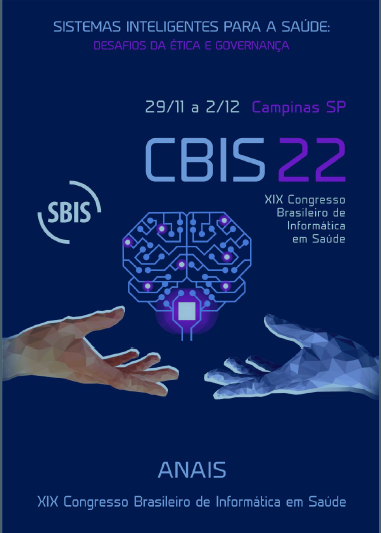Tele-education Strategies for coping with COVID-19 in Northeast Brazil
DOI:
https://doi.org/10.59681/2175-4411.v15.iEspecial.2023.1092Keywords:
Teleeducation, COVID-19, Digital HealthAbstract
Objective: To describe the educational technological strategies used in the fight against COVID-19 to update health professionals and the population. Method: It was an observational, exploratory and descriptive technological development study with a qualitative approach. Results: A tele-education environment was made available with 368 new users and 532 accesses, where it made available a collection of educational content through 17 educational videos with audiovisual resources and informative content. A chatbot was also made available to screen patients with symptoms of COVID-19 and to clarify doubts. Conclusion: The development of tele-education strategies for public health was very important in this period in which health education is being carried out in a virtual way for the understanding of topics about COVID-19.
References
Li Q, Guan X, Wu P, Wang X, Zhou L, Tong Y, et al. Early Transmission Dynamics in Wuhan, China, of Novel Coronavirus–Infected Pneumonia. N Engl J Med. https://doi.org/101056/NEJMoa2001316 [Internet]. 2020 Jan 29 [cited 2021 Oct 18];382(13):1199–207. Available from: https://www.nejm.org/doi/full/10.1056/nejmoa2001316
Organização Mundial de Saúde (OMS) Brasil. Organização Pan-Americana da Saúde (OPAS) Brasil. OMS declara emergência de saúde pública de importância internacional por surto de novo coronavírus [Internet]. Opas. 2020. p. 1–13. Available from: https://www.paho.org/pt/news/30-1-2020-who-declares-public-health-emergency-novel-coronavirus
Brasil. Protocolo de Manejo Clínico da Covid-19 na Atenção Especializada [recurso eletrônico]. Ministério da Saúde. 2020 Apr. 48 p. Available from: https://portalarquivos.saude.gov.br/images/pdf/2020/April/14/Protocolo-de-Manejo-Cl--nico-para-o-Covid-19.pdf
Dong Y, Mo X, Hu Y, Qi X, Jiang F, Jiang Z, et al. Epidemiology of COVID-19 among children in China. Pediatrics [Internet]. 2020;145(6). Available from: https://pediatrics.aappublications.org/content/pediatrics/145/6/e20200702.full.pdf
Bashshur R, Doarn CR, Frenk JM, Kvedar JC, Woolliscroft JO. Telemedicine and the COVID-19 pandemic, lessons for the future [Internet]. Vol. 26, Telemedicine and e-Health. Telemed J E Health; 2020. p. 571–3. Available from: https://pubmed.ncbi.nlm.nih.gov/32275485/
Smith AC, Thomas E, Snoswell CL, Haydon H, Mehrotra A, Clemensen J, et al. Telehealth for global emergencies: Implications for coronavirus disease 2019 (COVID-19). J Telemed Telecare [Internet]. 2020 Jun 1;26(5):309–13. Available from: https://pubmed.ncbi.nlm.nih.gov/32196391/
Wilder-Smith A, Freedman DO. Isolation, quarantine, social distancing and community containment: Pivotal role for old-style public health measures in the novel coronavirus (2019-nCoV) outbreak. J Travel Med [Internet]. 2020;27(2):1–4. Available from: https://pubmed.ncbi.nlm.nih.gov/32052841/
Martins RX, Flores VF. A implantação do Programa Nacional de Tecnologia Educacional (ProInfo): revelações de pesquisas realizadas no Brasil entre 2007 e 2011. Rev Bras Estud Pedagógicos [Internet]. 2015;96(242):112–28. Available from: https://www.scielo.br/j/rbeped/a/WhDJhQrDnPZ4tvPKWybvwKt/?lang=pt&format=pdf
Campos Filho AS, Lemos WB, Souza, RC, Lima, LLB. Realidade virtual como ferramenta educacional e assistencial na saúde: uma revisão integrativa.J.Health Inform. 2020 Abril-Junho; 12(2):58-63
Sousa MG, Oliveira EML, Coelho MMF, Miranda KCL, Henriques ACPT, Cabral RL. Validation of educational game for adolescents about the sexuality topic. Rev Pesqui Cuid é Fundam Online [Internet]. 2018;10(1):203–9. Available from: http://www.seer.unirio.br/cuidadofundamental/article/view/6030/pdf
Souza V, Gazzinelli MF, Soares AN, Fernandes MM, Oliveira RNG, Fonseca RMGS. The game as strategy for approach to sexuality with adolescents: theoretical-methodological reflections. Rev Bras Enferm [Internet]. 2017;70(2):394–401.
Abbasi M, Eslami S, Mohammadi M, Khajouei R. The pedagogical effect of a health education application for deaf and hard of hearing students in elementary schools. Electron Physician [Internet]. 2017;9(9):5199–205. Available from: http://www.ephysician.ir/2017/5199.pdf
A. K. Wardhana, R. Ferdiana and I. Hidayah, "Empathetic Chatbot Enhancement and Development: A Literature Review," 2021 International Conference on Artificial Intelligence and Mechatronics Systems (AIMS), 2021, pp. 1-6, doi: 10.1109/AIMS52415.2021.9466027.
Brooke J. SUS: A “Quick and Dirty” Usability Scale. Em: Usability Evaluation In Industry [Internet]. CRC Press; 1996 [citado 2022 ago 24]. p. 207–12. Available from: https://www.taylorfrancis.com/books/9781498710411/chapters/10.1201/9781498710411-35
Google. Dialogflow [Internet]. 2021. p. 1–2. Available from: https://cloud.google.com/dialogflow/docs/
Vosoughi S, Deb R, Aral S. The spread of true and false news online. MIT Initiative on the Digital Economy Research Brief [Internet]. 2017;1–5. Available from: http://ide.mit.edu/sites/default/files/publications/2017 IDE Research Brief False News.pdf
Cateb GF, Amaral S, Gonçalves SCL, Oliveira JRI, Prates RO, Chagas BA, et al. Pilot validation of a frontline chatbot to face COVID-19 using telehealth assistance. In: XXI Simpósio Brasileiro de Computação Aplicada à Saúde (SBCAS) [Internet]. 2021. p. 1–6. Available from: https://sol.sbc.org.br/index.php/sbcas_estendido/article/view/16108
Person B, Sy F, Holton K, Govert B, Liang A, Sars N. Fear and Stigma: The Epidemic within the SARS Outbreak. Emerg Infect Dis [Internet]. 2004;10(2):358–63. Available from: https://wwwnc.cdc.gov/eid/article/10/2/03-0750_article
Downloads
Published
How to Cite
Issue
Section
License
Copyright (c) 2023 Amadeu Sá de Campos Filho, Claudinalle Farias Queiroz de Souza, Jasna Mariane Soares Cavalcante, Nathalia Soares de Souza, Karolina de Cássia Lima da Silva, Letícia Moura Mulatinho, Lucilene Rafael Aguiar, Magdala de Araújo Novaes

This work is licensed under a Creative Commons Attribution-NonCommercial-ShareAlike 4.0 International License.
Submission of a paper to Journal of Health Informatics is understood to imply that it is not being considered for publication elsewhere and that the author(s) permission to publish his/her (their) article(s) in this Journal implies the exclusive authorization of the publishers to deal with all issues concerning the copyright therein. Upon the submission of an article, authors will be asked to sign a Copyright Notice. Acceptance of the agreement will ensure the widest possible dissemination of information. An e-mail will be sent to the corresponding author confirming receipt of the manuscript and acceptance of the agreement.

